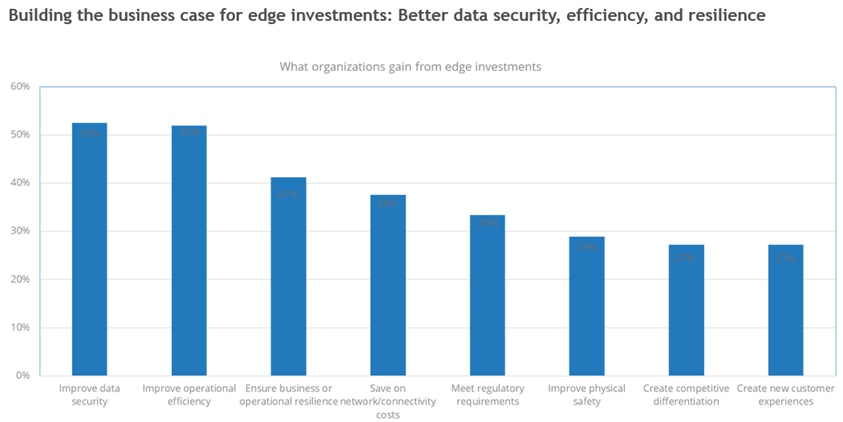Edge computing is a distributed computing paradigm that includes infrastructure and services outside of centralized, dedicated, and cloud datacenters that are closest to where data is created and consumed.
The ability to provide IT services at the edge is critical in our digital first world. It can help companies become more responsive, reduce the cost of data transmission and storage, and improve compliance with data governance laws. IDC images Worldwide Edge Spending Guide (February 2024) predicts that global revenue for edge computing will reach $232 billion this year, an increase of 15% over 2023. Continued growth is expected over the next few years.
On the surface, the cost argument for deploying edge devices is fairly straightforward: By processing data closer to where it is produced, organizations can reduce network and communication costs while improving operational efficiency. However the size and scale of fringe projects can raise capital quickly.
It is an investment in the edge of construction and operation all the time the right choice? Making the right choice for a particular implementation requires evaluating hard and soft costs.

IDC EdgeView 2024, n = 800
Simple cost of edge computing
In many ways, this is the easy part. IDC images Assessing the Cost and ROI of Edge Computing (June 2024) describes expensive.
Hardwoods include:
- Setting up infrastructure (servers, communication, storage, gateways, sensors/input devices, and devices) and integrating edge communication with it. The hardware requirements range from basic systems to enterprise-grade systems that are standalone, converged, or hyperconverged. If these systems are not already in place, they can be very expensive to install.
- Software to support computing at the edge. These include operating systems or application environments, remote management and security tools, analytics and data management systems, and application-related software.
- Manage and manage content flows between multiple devices, infrastructure and networks at the edge.
- Refactoring or rebuilding software so that it can work better at the edge and is automatically installed, patched, modified, and evaluated
- Data transmission and storage
- Power and cooling on the edge
- Remote monitoring platform
- Delivery services and continuous improvement
Indirect or hidden costs of edge computing
Indirect or hidden costs are also important, but difficult to quantify. It includes:
- Additional cost for remote maintenance, troubleshooting, and upgrades
- Cost of labor in a small area
- Long distance control
- Data transfer fees
Ways to reduce the cost of computers
One of the best ways to reduce the cost of a computer is to choose a user interface that is suitable for the edge, with cost as the main factor. Make a list of the programs you want to develop or use in the next five years, along with their requirements. Those with high workloads, high performance requirements, high data volumes, and latency-sensitive applications are good candidates.
Rather than using and running internal workflows, some organizations find it more cost-effective to use as-a-services. But there are other reasons besides cost to consider a way to manage work on edge computers. It’s often a good idea for businesses that don’t have a lot of expertise in edge deployments, or edge environments that don’t have technical experts readily available to troubleshoot if needed. This is especially true in sectors such as healthcare and retail, where edge environments can be very remote and distributed without IT staff being present at all locations. This model also helps organizations to start small with limited use cases at the edge and increase time without spending a lot of money.
The three methods are:
- Edge-driven services. This model is similar to a work arrangement, where the partner owns and works on the construction and operation. IDC images EdgeView 2024 The survey found that 36% of businesses say new investments at the edge will include managed services.
- Edge as a service. With this model, the partner owns the equipment and maintains it, but the company does the work. Companies pay a monthly fee.
- Cloud services for edge. One type of service in this category is a dedicated service provider like Amazon Outpost, where a public cloud provider places equipment provided to a single customer at a location of the customer’s choosing, and all associated services are owned by that customer. Another type of service is shared cloud computing where a public cloud provider provides resources at a location close to where the customer needs them. The same IDC survey found that 49% of organizations say their financial edge will include cloud-based solutions.
Here’s a good rule of thumb: If your organization can afford the hardware and communication systems in all areas, it may have the potential to be self-sustaining. If not, then it’s best to consider sustainability or some other type of edge-driven service.
Edge computing is having a moment, and it’s unlikely to go away anytime soon. Judging value on a case-by-case basis is a great way to get value from the edge for example without breaking the bank.
Find out more about IDC survey of technology leaders.
International Data Corporation (IDC) is the world’s leading provider of market intelligence, advice, and action on technology markets. IDC is a subsidiary of International Data Group (IDG Inc.), a leading global media technology, data, and marketing services company. Recently voted Company Analyst of the Year for the third time in a row, IDC’s Technology Leader Solutions provides you with technology guidance backed by our industry-leading research, strong leadership and development programs, and best-in-class benchmarking and intelligence insights. from experienced consultants in the industry. Contact us today for more information.
Karen D. Schwartz is an adjunct research advisor with IDC’s IT Executive Programs (IEP), focusing on business IT, digital marketing, disaster recovery, and data management. He has extensive experience as a researcher and business and technology journalist, covering a wide range of issues and topics. He often writes about cybersecurity, disaster recovery, storage, unified communications, and wireless technology. Karen holds a Bachelor of Arts degree from UCLA.
#Evaluating #comparative #cost #edge #computing
